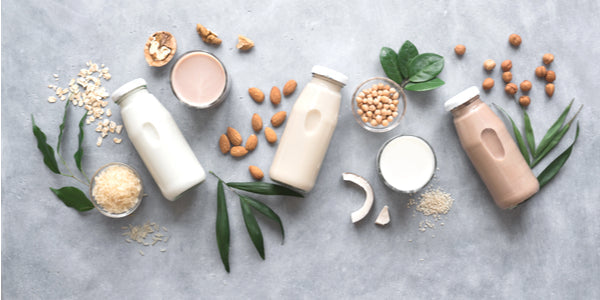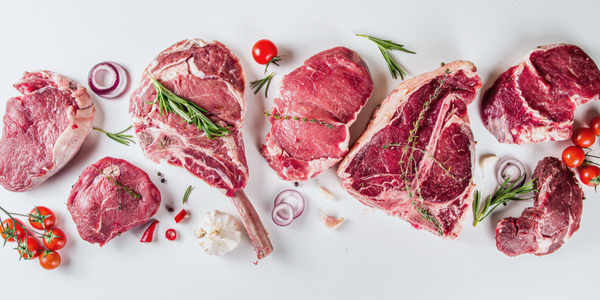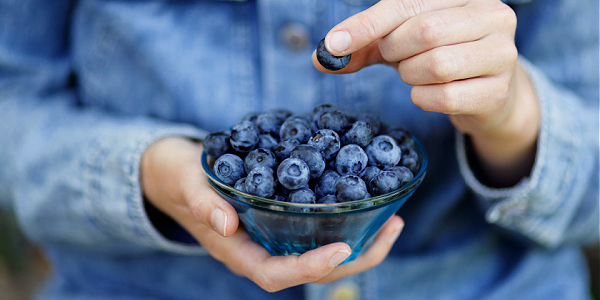
Plant-based milk dates back to ancient eras, although innovative strategies are taking it far into the future. For consumers, lactose-free milk and milk alternatives can easily get confusing, even though they have been around for ages.
Options like rice milk might sound like they come from a dinner plate instead of a carton. However, food technologists and food lovers alike find these kinds of milk promising options.
If intrigued by these innovative milks, read on to learn more about the different types of milk and how plant-based alternatives compare.
The Types of Milk
The word "milk" has been used for centuries to refer to the juices of plants. For example, in Asia as early as 1200 AD, coconut milk has been used as a nutrient-rich beverage and for ceremonial offerings.
Soy milk dates back to 14th century China and is still used today in traditional Chinese cooking. Horchata recipes, using a blend of almond-based milk and other ingredients, have been used since the 8th century as a traditional Spanish drink. Other alternatives and milky beverage blends are more recent discoveries, such as rice milk.
As scientific advances were made over the early 20th century, the need for non-dairy milk alternatives grew. For those with lactose intolerance, even a little milk can cause distressing symptoms. Luckily, a booming plant-based market has emerged and includes options for everyone.
Dairy Milk
Traditional dairy milk comes from many different kinds of animals. Cows, buffalos, sheep, camels, and goats all produce milk. The most common milk for human consumption is cow's milk.
Non-Dairy Alternatives
In general, non-dairy options are a combination of plant-based liquids and added vitamins in minerals. This combination makes non-dairy milk a worthy competitor in the milk market, in every category from texture to taste.
Blends
Likely the most recent innovation in dairy drinks, plant-based milk is beginning to be combined in tasty blended beverage options. Duos like oat and almond milk drinks or cold brew beverage combinations are not only trendy but increasingly show they may be here to stay.
Fermented Plant-Based Beverages
Fermented drinks in the plant-based market are highly anticipated and primed to thrive. Recent studies have discovered that fermentation of plant-based milk during the production process can increase the nutrient balance and flavor profile.
Plant-Based Milk
Plant-based milk does not contain lactose or cholesterol. They also tend to be lower in calories as long as added sugars are not involved. This makes them a great option for consumers beyond the lactose-sensitive population.
Many plant-based kinds of milk contain added calcium and B vitamins to make them comparable to dairy options. The following plant milk comes from these common varieties:
• Almond milk
• Cashew milk
• Coconut milk
• Hazelnut milk
• Hemp milk
• Oat milk
• Rice milk
• Soy milk
While most plant-based milk is produced through a controlled fermentation process to achieve the highest potential nutrient content, the functional components and compositions vary from one beverage brand to another.
Pros & Cons of Plant-Based Beverages
Studies show that growing children can include plant-based milk in their diet daily, post-weaning. In the first 12 months of life, breast milk is optimal for childhood growth. After this period, however, plant-based milk seems to measure up to dairy in almost every category.
Compared with conventional milk, plant-based milk may be less harmful than dairy milk for certain groups. Cow's milk is rich in calcium, but research over time shows that it does not seem to reduce fractures. In fact, cow's milk can carry many potential risks, including association with type 1 diabetes onset, anemia in toddlers, lactose intolerance, cow's milk protein allergy, and colic in infants.
Plant-based food often has low availability of iron, zinc, iodine, and vitamin A. These nutrients are of concern and common deficiencies in developing countries. However, many of the studies evaluating nutrient intake fail to account for how balanced the participant's diets are.
In other words, plant-based milk, as part of a balanced diet, can be easily included to complete a diet adequate in all vitamins and minerals. Compare the adverse effects of consuming cow's milk against potential risks and benefits of plant-based options before making a decision.
Increasing Bioavailability
Luckily, by learning certain cooking techniques and ideal combinations of foods, significant improvements in nutrient availability are possible. For example, fermentation, heat treatment, sprouting, and malting processes have been shown to enhance the bioavailability of nutrients such as iron and vitamin A from plant foods.
Culinary Tips & Tricks
It might help to try out cuisine from a different culture. Food components and culinary techniques common in India or tropical countries tend to improve the availability of nutrients in plant-based foods used as common ingredients.
Plant-based beverages can also help to add variety to a menu.
The Future of Plant-Based Milk
A recent study found that plant-based milk may possibly be used as a therapeutic tool. Currently, more considerations must be taken for correct labeling and prescription of plant-based products before they are widely recommended as therapy options. Even with these limitations, the future for alternative milk products looks promising.
Researchers are also finding that with specific nutritional advice, breastfeeding women can follow a milk-free diet and decrease health risks. Accounting for calcium is crucial in this process, but it shows great potential for plant-based alternatives for all ages and stages of life.
The Bottom Line on Plant-based Milk
Plant-based milk can still be a great source of nutrients such as calcium. Many plant-based kinds of milk are fortified to mirror the nutrient profile of cow's milk and can fulfill the daily dairy recommendation of 2 to 3 cups.
While plant-based milk lacks some major nutrients of concern, it can easily help round out a well-balanced diet where other foods make up for the beverage's deficiencies.
Nutritional Value
Plant foods often provide an impressive blend of vitamins and minerals. Common options are fortified with calcium and other nutrients to bring them closer to the standard of cow's milk. Plant-based alternative milk can also add much-needed protein and fiber to the diet.
Calcium, vitamin D, and dietary fiber are considered dietary components of public health concern. Plant-based milk alternatives offer a rich source of vitamins and minerals in addition to introducing a new approach to tackling the nation's most common nutrient deficiencies.
Vitamins and Minerals
Plants offer many important nutrients, and many of those make it into the milk. During beverage formulation, water, flavors, vitamins, and minerals may be added to the plant-based milk.
A potential problem with plant-based foods is that they can lack key nutrients, such as vitamin B12, vitamin D, calcium, and omega-3 fatty acids. Luckily, scientists and producers are working together to create plant-based products that are fortified with the necessary nutrition that plant-based alternatives naturally lack.
Protein
Plant-based milk is known for their high protein contents when compared to other beverages. Soy milk and pea protein especially make great options for plant-based protein.
Fiber
Fiber is recognized as a dietary component of public health concern, according to the most recent Dietary Guidelines for Americans. It is estimated that over 90% of women and 97% of men do not meet their recommended intakes for dietary fiber.
An important aspect of getting more fiber is replacing processed or high-fat products with beans, peas, and lentils of similar nutrient benefits. Certain plant-based milk options, such as oat milk, contain soluble fiber as an additional ingredient.
Added Ingredients
During the formulation stage, various amounts of added sugars and fat can be added. Some fats are used to modify the milk along with stabilizing or thickening agents. These ingredients are often added to simulate the sensory properties of animal-based options.
It is important to read the label of plant-based milk to make sure the added amounts of sugar, fat, or artificial ingredients do not negate the good that plant benefits can do. In other words, plant-based doesn't automatically equal healthy. Be sure to flip the beverage over and double-check what's in the drink.
Allergies
Some folks that have nut allergies might be better off sticking to cow's milk or other varieties instead of nut milk. Luckily, nut milk is not the only alternative option for dairy-like beverages. Oat and rice drinks can also be excellent options.
Nutrients of Concern
Importantly, look for fortified products with supplemented nutrients when drinking plant-based milk. If the diet does not account for these missing nutrients, the following vitamins and mineral deficiencies could occur:
• Calcium
• Zinc
• Zinc
• Iodine
• Vitamins B2 (Riboflavin), B12, D, and A
• Amino acids
Lactose-Free Milk vs Dairy Milk
Lactose, a type of sugar found in dairy products, can be hard for some people to digest and may cause distressing symptoms. It is estimated that as many as 70 to 75 percent of the population is on the spectrum of lactose intolerance.
Lactose-free milk is a commercial product that mimics milk but is free of lactose. This is a viable option for those intolerant to lactose while still enjoying a glass of milk.
How Lactose-Free Milk Works
When lactose-free milk is formulated, lactase (an enzyme that breaks down lactose) is added to the milk. In other words, since lactose-free milk contains the component needed to break lactose down, it can be a good alternative to conventional dairy milk.
That being said, lactose-free milk is still a dairy product and can cause allergic reactions. It is also produced with cow's milk, excluding it from a vegan eating pattern. Those who are on a dairy-free diet for personal or health reasons may also want to consider avoiding both lactose-free milk and dairy milk.
Taste and Texture
Milk free of lactose generally has a similar taste and texture as milk. The added lactase, which breaks down more complex sugars into simple sugars, may give lactose-free milk a sweeter taste. Taste buds generally recognize simple sugars as sweeter than complex ones.
Nutrient Quality
Alternative kinds of milk that are lactose-free often have a similar nutrient profile to regular dairy milk. Generally, lactose-free milk will contain the following nutrient qualities, which are similar to dairy milk:
• 8 grams of protein per 1 cup serving
• High in micronutrients (i.e. calcium, phosphorus, vitamin B12, riboflavin)
• Enriched with vitamin D
Dairy milk may have additional nutrients that are beneficial to a well-rounded diet. These vitamins and minerals include vitamins A, B5 (pantothenic acid), and B3 (niacin). Unless for personal preference or health reasons, most health practitioners recommend low-fat dairy milk as a great option for meeting protein and bone health needs.
Can lactose-free milk be substituted for dairy milk in recipes?
Typically, lactose-free milk can be swapped for dairy milk in a recipe. Usually, a product will contain recommendations or instructions for how best to use their product in a recipe. Some lactose-free milk can taste sweeter, so that may be an important consideration for substitutions.
It is crucial to remember that while lactose-free milk and plant-based milk can be substituted in many recipes, non-dairy milk has not yet proven to be nutritionally identical or near as bioavailable as dairy milk. Essentially, you can treat lactose-free milk as a substitute in
Other Concerns
Needing a lactose-free alternative is not the only reason to switch to plant-based beverages. Consumers are increasingly interested in beverages due to concerns tied to health, sustainability, and ethical considerations.
For consumers, a mix of factors plays into the plant-based decision. In a recent study, consumers were found to value price, texture, sweetness, shelf-like, and package size. Ultimately, personal preference determines the plant-based product chosen.
Both non-dairy milk beverages and conventional milk choices can vary in terms of nutrient quality, bioavailability, and disease risk. Whether a drinker of dairy milk or non-dairy milk alternatives, it is important to consume a complete nutritional diet.
Overall, cow's milk and fortified plant-based beverages can both be excellent candidates for achieving that goal.
References:
Facioni MS, Raspini B, Pivari F, Dogliotti E, Cena H. Nutritional management of lactose intolerance: the importance of diet and food labelling. J Transl Med. 2020;18(1):260. doi: 10.1186/s12967-020-02429-2.
Januszko P, Lange E. Milk-free diet followed by breastfeeding women. Rocz Panstw Zakl Hig. 2020;71(2):181-189. doi: 10.32394/rpzh.2020.0118.
Link R. What is Lactose-Free Milk. Healthline. 2018. www.healthline.com/nutrition/lactose-free-milk.
Mennini M, Calandrelli V, Fierro V, Dahdah L, Fiocchi A. Plant-based Milks: A Possible Therapeutic Tool if Correctly Labeled and Prescribed. J Pediatr Gastroenterol Nutr. 2020;71(4):e133. doi: 10.1097/MPG.0000000000002881.
McClements DJ. Development of Next-Generation Nutritionally Fortified Plant-Based Milk Substitutes: Structural Design Principles. Foods. 2020:9(4);421. doi: 10.3390/foods9040421.
McHugh T. How Plant-Based Milks Are Processed. Institute of Food Technologists. 2018. https://www.ift.org/news-and-publications/food-technology-magazine/issues/2018/december/columns/processing-how-plant-based-milks-are-processed.
Paul AA, Kumar S, Kumar V, Sharma R. Milk Analog: Plant based alternatives to conventional milk, production, potential and health concerns. Crit Rev Food Sci Nutr. 2020;60(18):3005-3023. doi: 10.1080/10408398.2019.1674243.
Platel K, Srinivasan K. Bioavailability of Micronutrients from Plant Foods: An Update. Crit Rev Food Sci Nutr. 2016'56(1):1608-19. doi: 10.1080/10408398.2013.781011.
Singhal S, Baker RD, Baker SS. A Comparison of the Nutritional Value of Cow's Milk and Nondairy Beverages. J Pediatr Gastroenterol Nutr. 2017;64(5):799-805. doi: 10.1097/MPG.0000000000001380.
Scholz-Ahrens KE, Ahrens F, Barth CA. Nutritional and health attributes of milk and milk imitations. Eur J Nutr. 2020;59(1):19-34. doi: 10.1007/s00394-019-01936.
Tangyu M, Muller J, Bolten CJ, Wittmann C. Fermentation of plant-based milk alternatives for improved flavour and nutritional value. Appl Microbiol Biotechnol. 2019;103(23-24):9263-9275. doi: 10.1007/s00253-019-10175-9.
Undeniably Dairy. Dairy Nutrition. Dairy Management Inc. 2021. www.usdairy.com/dairy-nutrition.
US Department of Health & Human Services. Dietary Guidelines for Americans 2020-2025. US Department of Agriculture. 2020. dietaryguidelines.gov/.







